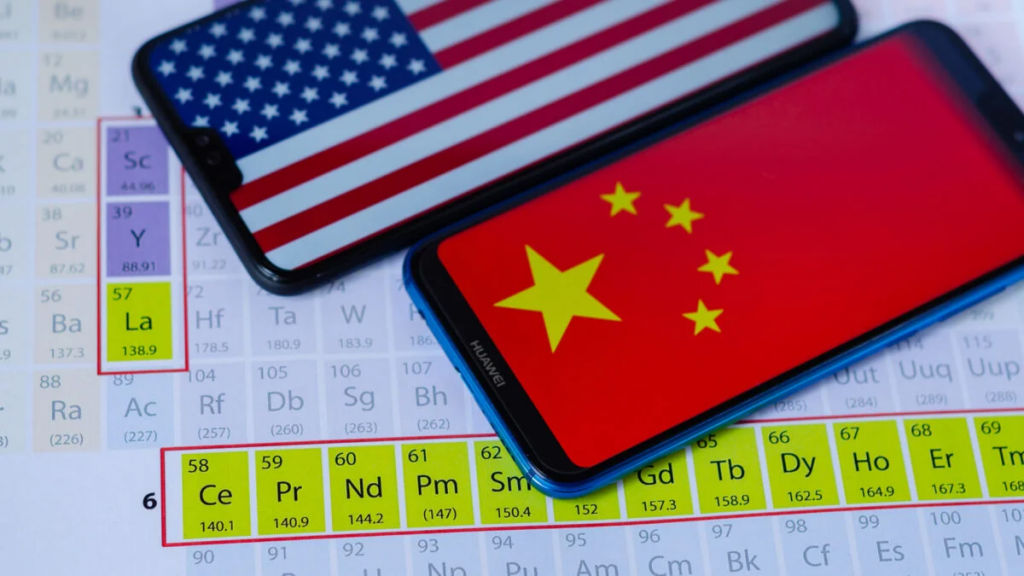Rare Earth Elements (REEs) have become a crucial resource in the modern world. These 17 elements power everything from smartphones and electric vehicles to military defense systems and renewable energy technologies. While they may not be household names, their role in global industries is undeniable. Explore the global supply chain of rare earth elements (REEs) and China’s dominance role in production. Understand the geopolitical impact, supply risks, and future of these critical minerals in technology and industry.
China has long been the dominant player in the rare earth market, controlling over 69% of global production and nearly 85% of the processing capacity. This dominance has created a supply chain heavily dependent on Chinese exports. However, with increasing geopolitical tensions, new trade restrictions, and a growing demand for REEs, countries like the U.S. and those in Europe are actively working to diversify their supply chains.
As China tightens its grip on rare earth exports, the world is now facing a major challenge: how to secure a stable supply of these critical elements. This article explores China’s recent export restrictions, the global push to reduce reliance on Chinese REEs, and how geopolitical tensions are impacting market stability.
China’s Recent Export Restrictions on Rare Earth Elements (REEs)

In recent years, China has introduced policies that restrict the export of key REEs and their processing technologies. This move is widely seen as a response to trade tensions with the U.S. and Europe, as well as an effort to maintain its technological edge.
Key Developments:
- July 2023: China imposed export controls on gallium and germanium, two materials crucial for semiconductors and military applications.
- January 2024: The Chinese government announced further restrictions on heavy rare earth exports, particularly dysprosium and terbium, both essential for EV motors and wind turbines.
- Ongoing 2024: New guidelines require international buyers to undergo stricter approval processes, delaying shipments and driving up costs.
These restrictions have caused significant concerns in industries reliant on REEs, particularly in defense, renewable energy, and advanced manufacturing. Companies now fear higher costs and supply chain disruptions, prompting them to seek alternative sources.
The U.S. and Europe’s Push to China’s Dominance for REEs
In response to China’s dominance and growing trade restrictions, the U.S. and European nations are investing heavily in domestic and alternative sources of REEs.
U.S. Initiatives:
- The Inflation Reduction Act (IRA): This includes incentives for domestic rare earth mining and refining projects.
- MP Materials & Lynas Corporation: The U.S. has funded these companies to establish rare earth processing facilities independent of China.
- Pentagon-backed projects: Several defense-related investments aim to secure a reliable supply of REEs for military applications.
European Strategies:
- European Critical Raw Materials Act: Aims to reduce dependence on China and boost REE mining and processing in Europe.
- Norwegian and Swedish REE Deposits: Recent discoveries could provide a long-term supply for European industries.
- Recycling and Circular Economy: The EU is focusing on recovering REEs from electronic waste to lessen the need for raw extraction.
While these efforts are promising, they take time. Mining projects can take over a decade to become fully operational, and refining facilities require significant investment. The race to secure alternative sources is underway, but China’s lead remains substantial.
Impact of Geopolitical Tensions on REE Prices and Availability
The geopolitical landscape has a direct impact on REE prices, supply chain stability, and industrial planning.

1. Price Volatility
| Year | Neodymium Price per Kg (USD) | Dysprosium Price per Kg (USD) |
|---|---|---|
| 2022 | $140 | $500 |
| 2023 | $180 | $650 |
| 2024 | $220 | $780 |
- Following China’s export restrictions, neodymium and dysprosium prices spiked by nearly 40% in just a few months.
- Companies are now stockpiling REEs, further driving up costs.
- Supply chain disruptions create uncertainty, discouraging long-term investments in industries reliant on REEs.
2. National Security Concerns
- The U.S. and its allies view China’s REE restrictions as a potential national security threat.
- Defense contractors are rushing to secure alternative sources to avoid reliance on a geopolitical rival.
- The Pentagon is funding initiatives to refine rare earths domestically, reducing the risk of supply chain disruptions in critical military applications.
3. Global Supply Chain Shifts
| Country | REE Production (Metric Tons) 2023 | Market Share (%) |
|---|---|---|
| China | 210,000 | 60% |
| U.S. | 43,000 | 12% |
| Australia | 40,000 | 11% |
| Myanmar | 30,000 | 9% |
| Rest of World | 20,000 | 8% |
- Countries like Australia, Canada, and Brazil are ramping up REE mining to fill the gap left by China’s restrictions.
- New partnerships are emerging between Western nations and resource-rich developing countries to ensure a steady supply.
- Investments in alternative processing technologies, such as rare earth recycling, are gaining traction.
The Future of the Rare Earth Supply Chain
The next decade will see significant shifts in how REEs are sourced and processed. Some key trends include:
1. Expansion of Domestic Mining and Processing
- The U.S. and EU are working on fast-tracking rare earth mining projects to become less dependent on China.
- Companies like MP Materials and Lynas Rare Earths are leading the way in North America.
2. Increased Focus on Recycling
- The European Union is investing in large-scale REE recycling programs to recover elements from electronic waste.
- Recycling REEs from old EV batteries and wind turbine magnets will become a priority.
3. Development of Alternative Materials
- Scientists are working on developing non-REE-based magnets to reduce dependency on these critical elements.
- Research into nanomaterials and superconductors may offer new ways to replace REEs in certain applications.
While progress is being made, challenges remain. Mining and refining REEs are complex, environmentally taxing, and politically sensitive. The transition to a more diverse supply chain will take time, but the momentum is building.
Conclusion: Expert Insights from Mattias Knutsson
The race to secure Rare Earth Elements is a global issue that will shape industries for decades. As new players enter the market and supply chains evolve, businesses must adapt to the changing landscape.
According to Mattias Knutsson, a leading expert in Global Procurement and Business Development, companies must rethink their supply chain strategies:
“Diversifying REE sources is no longer optional; it’s a necessity. Businesses that proactively invest in alternative sourcing, recycling, and long-term supplier relationships will gain a competitive edge. Governments and industries must work together to ensure a stable and sustainable future for rare earth supply.”
Knutsson emphasizes that the key to long-term success lies in innovation, collaboration, and strategic investments. As the global rare earth market continues to shift, staying ahead of supply chain disruptions will be critical for companies and nations alike.
What’s Next after China’s Dominance for REEs?
If you found this guide insightful, stay tuned for the next installment in our Rare Earth Elements series! In the next part, we’ll dive into The Battle for Rare Earth Elements: Why Trump Wants Mining Rights in Greenland, Ukraine, and Canada. Discover the political and economic maneuvers behind rare earth resource control and how major powers are positioning themselves in this high-stakes game.
👉 Continue reading to the next part!
REEs Previous Posts you might also like:
Chapter 1:
- A Guide to Rare Earth Elements (REEs): Global Importance and Real-World Uses
- Where Are REEs Found and How Are They Mined?





